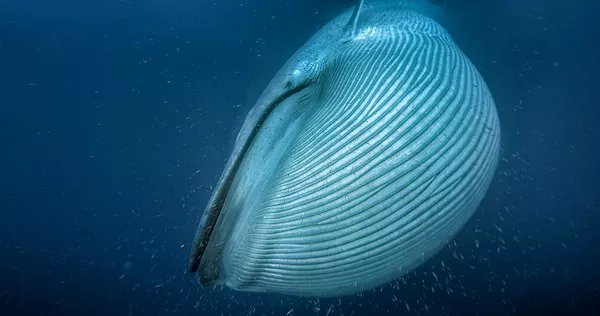Whales, the majestic giants of the ocean, have captivated human imagination for centuries with their sheer size, graceful movements, and mysterious nature. Among these magnificent creatures, some stand out as the largest and most awe-inspiring of them all. In this article, we embark on a journey to discover which whale holds the title of the biggest whale in the world and explore the fascinating characteristics of these oceanic behemoths.
5 World’s Largest Whale Species
1. The Blue Whale: The True Colossus of the Seas
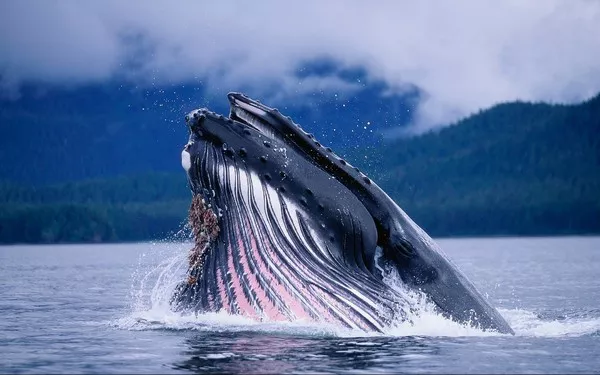
At the top of the list of the world’s largest whales reigns the mighty blue whale (Balaenoptera musculus), an iconic symbol of the ocean’s vastness and grandeur. With its massive body and unparalleled size, the blue whale holds the title of the largest animal ever known to have existed on Earth. Stretching up to 100 feet (30 meters) in length and weighing as much as 200 tons, these marine giants dwarf even the largest dinosaurs that once roamed the planet.
Blue whales are renowned for their distinct bluish-gray coloration and streamlined bodies, which enable them to effortlessly glide through the water with remarkable agility despite their immense size. Their enormous mouths, equipped with baleen plates for filter-feeding, allow them to consume vast quantities of krill, their primary prey, in a single gulp. With each breath, blue whales expel a towering spout of water into the air, a spectacle that never fails to inspire awe in those lucky enough to witness it.
Found in oceans around the world, blue whales undertake long migrations across vast stretches of open water in search of food and suitable breeding grounds. Despite their immense size, they are surprisingly elusive creatures, often blending seamlessly into the vastness of the oceanic expanse. As apex predators, blue whales play a crucial role in maintaining the delicate balance of marine ecosystems, their presence serving as a testament to the importance of conserving our planet’s oceans.
2. The Fin Whale: Second Only to the Blue Whale
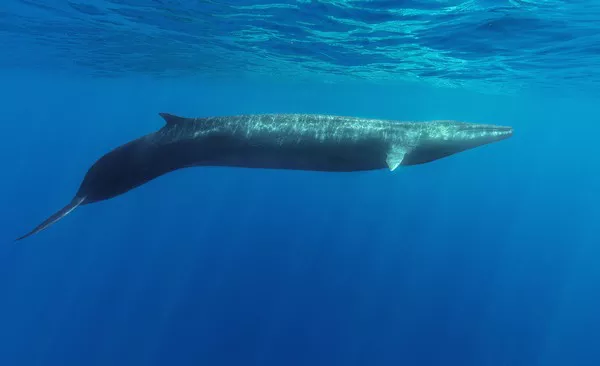
While not quite as large as their blue counterparts, fin whales (Balaenoptera physalus) still rank among the largest animals on Earth, earning them the title of the second-largest whale species. Reaching lengths of up to 85 feet (26 meters) and weighing up to 80 tons, fin whales possess formidable proportions that command respect and admiration.
Fin whales are distinguished by their sleek, streamlined bodies and distinctive asymmetrical coloration, with a lighter underside and a darker back. Their long, slender bodies enable them to reach impressive speeds, making them one of the fastest cetaceans in the ocean. Like blue whales, fin whales are filter feeders, using baleen plates to strain small fish and krill from the water as they glide through the ocean depths.
These magnificent creatures inhabit oceans worldwide, from polar regions to tropical waters, where they roam in search of food and suitable breeding grounds. Despite their immense size, fin whales are surprisingly agile and graceful swimmers, capable of diving to depths of several hundred meters in pursuit of prey. However, like many whale species, they face numerous threats from human activities, including habitat degradation, pollution, and ship strikes.
3. The Humpback Whale: The Iconic Singer of the Seas
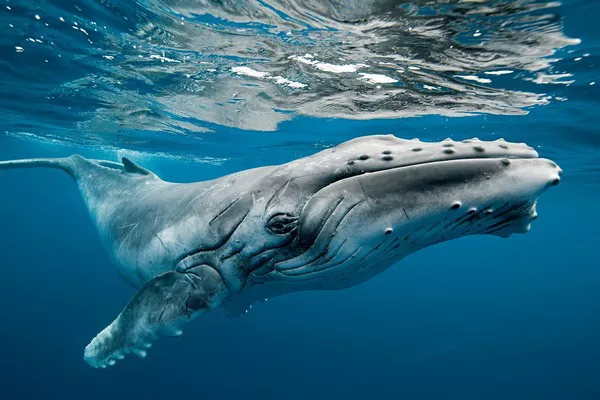
Known for their acrobatic leaps, haunting songs, and intricate patterns of behavior, humpback whales (Megaptera novaeangliae) hold a special place in the hearts of marine enthusiasts around the world. While not as large as blue whales or fin whales, humpbacks still rank among the largest baleen whales, with adult individuals reaching lengths of up to 60 feet (18 meters) and weighing up to 40 tons.
Humpback whales are renowned for their distinctive body shapes, characterized by long pectoral fins, knobbly heads, and bumpy protrusions on their rostrums. These unique features, combined with their playful and curious nature, make humpbacks easily recognizable and beloved by whale watchers and researchers alike. One of the most remarkable aspects of humpback behavior is their complex and melodious songs, which are thought to play a role in communication and mating rituals.
Found in oceans worldwide, humpback whales undertake extensive migrations between breeding and feeding grounds, traveling thousands of miles each year. During the breeding season, male humpbacks engage in elaborate courtship displays, including breaching, slapping their fins, and vocalizing loudly to attract potential mates. Humpback calves are born in warmer waters, where they spend their first few months nursing and gaining strength before embarking on their first migration alongside their mothers.
4. The Sperm Whale: The Largest Toothed Predator
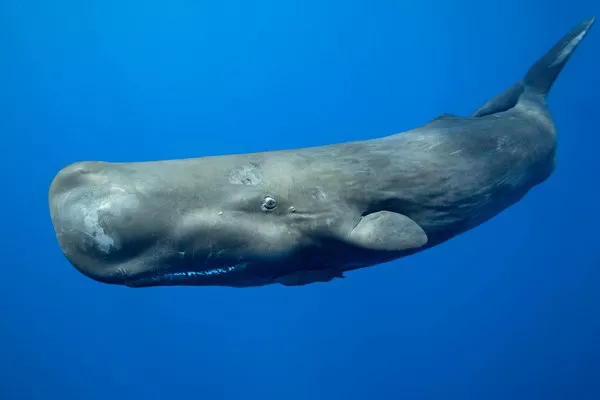
While not as physically massive as some baleen whales, sperm whales (Physeter macrocephalus) hold the title of the largest toothed predators in the world, with adult males reaching lengths of up to 60 feet (18 meters) and weighing up to 50 tons. Despite their imposing size, sperm whales possess a sleek and muscular body shape that enables them to navigate the ocean depths with remarkable agility and precision.
Sperm whales are distinguished by their large, block-shaped heads, which contain the largest brains of any animal on Earth. These massive organs enable sperm whales to engage in complex social behaviors and sophisticated hunting strategies, including deep dives lasting up to 90 minutes in search of their preferred prey: giant squid and deep-sea fish. Sperm whales are also known for their distinctive blowholes, located on the left side of their heads, which produce a distinctive forward-pointing spout when they surface to breathe.
Found in oceans worldwide, sperm whales are highly social animals, often traveling in stable family groups known as pods. Female sperm whales and their calves form tight-knit bonds, with females relying on the collective knowledge and experience of the group to navigate the challenges of life in the deep ocean. Despite their formidable size and intelligence, sperm whales face numerous threats from human activities, including entanglement in fishing gear, habitat degradation, and pollution.
5. The Bowhead Whale: The Longest-Living Mammal
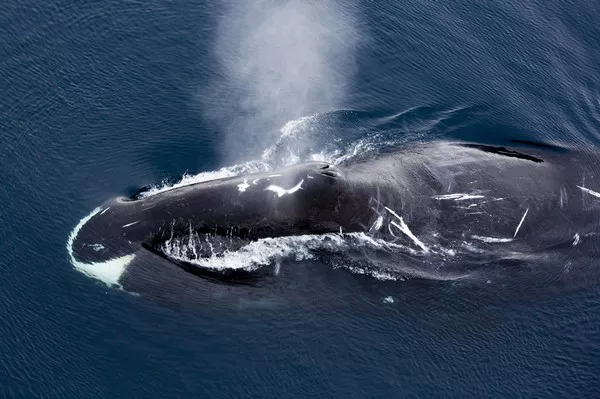
The bowhead whale (Balaena mysticetus) holds the distinction of being the longest-lived mammal on Earth, with some individuals surviving for more than 200 years. While not as physically massive as some other whale species, bowheads possess robust and stocky bodies, with adult individuals reaching lengths of up to 60 feet (18 meters) and weighing up to 100 tons.
Bowhead whales are characterized by their massive, bow-shaped heads, which account for up to one-third of their total body length. These distinctive heads are equipped with baleen plates that enable bowheads to filter large quantities of zooplankton and small fish from the water as they swim with their mouths agape. Despite their formidable size, bowhead whales are surprisingly agile swimmers, capable of breaching clear of the water’s surface in spectacular displays of strength and grace.
Found in the Arctic and subarctic regions, bowhead whales undertake extensive migrations between feeding and breeding grounds, traversing vast stretches of open water in search of food and suitable habitat. Despite their impressive longevity, bowhead whales face numerous threats from climate change, habitat loss, and hunting by indigenous communities. Conservation efforts are underway to protect and preserve these remarkable creatures and ensure their continued survival in the face of mounting environmental challenges.
In conclusion, the world’s oceans are home to a diverse array of whale species, each possessing its own unique adaptations and ecological significance. From the towering blue whale to the elusive sperm whale, these magnificent creatures inspire wonder and awe in all who encounter them. As stewards of the ocean, it is our responsibility to protect and preserve these majestic giants for future generations to appreciate and admire. Through conservation efforts and responsible stewardship, we can ensure that these extraordinary animals continue to thrive in the vast and mysterious realm of the ocean.
You Might Be Interested In:

